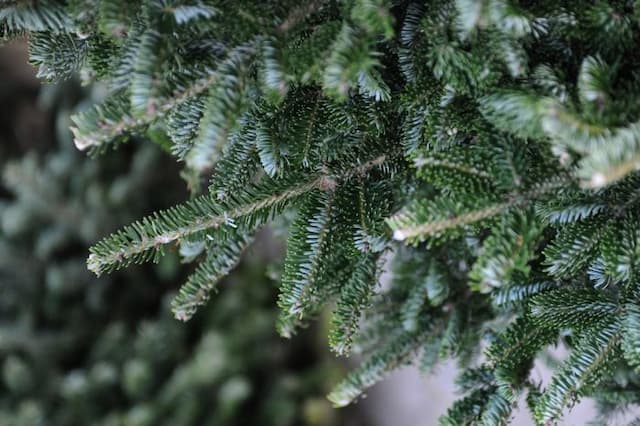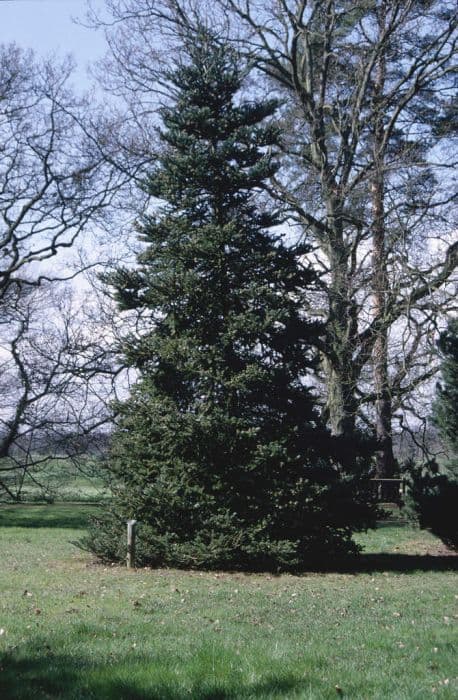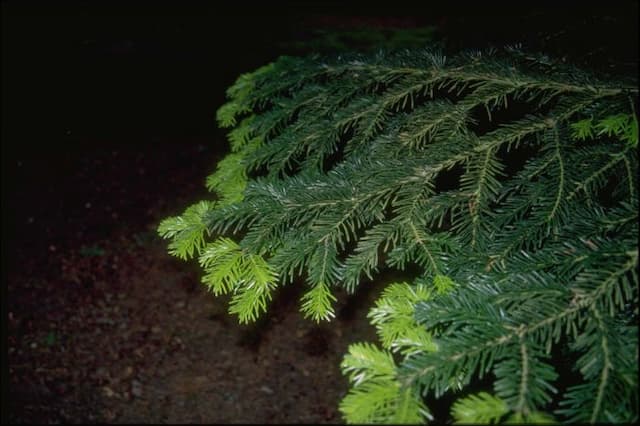Pinus parviflora 'Bonnie Bergman'

ABOUT
The Japanese white pine known as 'Bonnie Bergman' is a distinctive cultivar that boasts a striking visual profile. Characterized by its tightly arranged needles that exhibit a soft blue-green color, the plant exudes a serene and somewhat silvery glimmer. This color palette allows 'Bonnie Bergman' to provide a gentle contrast within a garden setting, particularly when placed among plants with darker or more vividly green foliage. The plant's needles are grouped in bundles, a typical feature of its kind, which gives the branches a more robust and textured appearance. The needles themselves are finely pointed, contributing to the overall clean and precise structure of the plant. In bright light, the needles may reflect a lively sheen, further enhancing the blue-green hue that makes this cultivar sought after. Adding to its distinctive look, 'Bonnie Bergman' produces cones that are small and often take on a nuanced coloration that complements the needles, generally residing in the more muted side of the color spectrum. These cones start off as tender and green, then mature into harder, woody structures with a warmer tone. The overall form of 'Bonnie Bergman' is compact and well-defined, presenting a dense and conical shape. This structural form creates a focus on the textural play of light and shadow across the foliage, constituting a visual interest that persists throughout the year. Its evergreen nature ensures that it retains its aesthetic appeal across seasons, making it a valuable ornamental addition to any garden or landscape.
About this plant
 Names
NamesFamily
Pinaceae
Synonyms
Japanese White Pine, Five-needle Pine, Bonnie Bergman Pine
Common names
Pinus parviflora 'Bonnie Bergman'.
 Toxicity
ToxicityTo humans
The Japanese White Pine is generally considered non-toxic to humans. There are no known toxic effects from ingesting or handling the plant. However, as with many plants, individual allergies or sensitivities may exist.
To pets
The Japanese White Pine is generally considered non-toxic to pets such as dogs and cats. There are no known significant toxic effects related to the ingestion of this plant by pets. However, consumption of non-food items by pets can sometimes lead to gastrointestinal upset or obstruction, and individual sensitivities may vary.
 Characteristics
CharacteristicsLife cycle
Perennials
Foliage type
Evergreen
Color of leaves
Green
Height
6 feet (1.83 meters)
Spread
4 feet (1.22 meters)
Plant type
Tree
Hardiness zones
5
Native area
Japan
Benefits
 General Benefits
General Benefits- Ornamental Appeal: Pinus parviflora 'Bonnie Bergman' offers an attractive form and blue-green needle foliage that enhances garden aesthetics.
- Ease of Care: It is relatively low maintenance, requiring minimal pruning and care once established.
- Drought Tolerance: Once established, it can tolerate periods of drought, making it suitable for xeriscaping and water-efficient landscapes.
- Longevity: Pines are known for their longevity, meaning 'Bonnie Bergman' can be a long-term feature in a landscape.
- Wildlife Habitat: Provides habitat and food for wildlife such as birds and small mammals.
- Soil Stabilization: Its root system can help prevent soil erosion, especially in sloped areas.
- Seasonal Interest: Offers year-round visual interest, especially in winter when other plants may have lost their leaves.
- Cold Hardy: It is capable of withstanding cold temperatures, making it suitable for cooler climates.
 Medical Properties
Medical PropertiesThis plant is not used for medical purposes.
 Air-purifying Qualities
Air-purifying QualitiesThis plant is not specifically known for air purifying qualities.
 Other Uses
Other Uses- Japanese White Pine bonsai: Pinus parviflora 'Bonnie Bergman' is often trimmed and trained to create beautiful, miniature bonsai trees that are revered for their aesthetic and cultural significance.
- Photography subject: Due to its unique form and aesthetic appeal, the Japanese White Pine is frequently used in landscape photography, capturing the beauty of the trees in various seasons.
- Educational tool: Botanical gardens and educational programs use the Japanese White Pine to teach about coniferous trees, plant growth patterns, and the art of bonsai.
- Needle crafts: The needles of the tree can be used in various traditional needle crafts, such as making pine needle baskets or decorative items.
- Culinary garnish: In some gourmet dishes, the non-toxic needles of the Japanese White Pine can be used as an aromatic garnish to add a hint of forest flavor.
- Theme gardens: The species is often included in Japanese-themed gardens outside Japan, providing an authentic touch of Japanese horticulture and aesthetics.
- Winter garden interest: Because of its evergreen nature and resilience to cold, the Japanese White Pine adds color and life to gardens during the winter months.
- Soil erosion control: When planted in mass, the deep root systems of Japanese White Pine trees can help stabilize soil and prevent erosion on slopes and banks.
- Urban green spaces: The tree is sometimes planted in urban environments to add greenery and nature to cityscapes due to its relatively compact size and tolerance of pruning.
- Wildlife habitat: Although it's a cultivated variety, the Japanese White Pine can provide shelter and nesting sites for birds and other small wildlife in a garden setting.
Interesting Facts
 Feng Shui
Feng ShuiThe Japanese White Pine is not used in Feng Shui practice.
 Zodiac Sign Compitability
Zodiac Sign CompitabilityThe Japanese White Pine is not used in astrology practice.
 Plant Symbolism
Plant Symbolism- Longevity: The Pinus parviflora, commonly known as Japanese White Pine, often symbolizes longevity due to its potential to live for hundreds of years.
- Endurance: Its strength and ability to withstand harsh conditions translate into a symbol of endurance and perseverance.
- Peace: In Japanese culture, pine trees are associated with peace, good health, and tranquility, due to their evergreen nature and calming presence in gardens.
- Festivity: They are often used in festive decorations in various cultures, representing celebration and joy.
- Immortality: As an evergreen, the Japanese White Pine also represents immortality, echoing the eternal life cycle with its year-round green needles.
 Water
WaterThe Japanese White Pine 'Bonnie Bergman' should be watered deeply but infrequently, allowing the soil to dry out slightly between waterings. Water the tree with approximately 1 to 2 gallons every week during the growing season, and less during winter when the tree's growth slows down. Ensure that the water penetrates the soil deeply, reaching the roots rather than just wetting the surface. During periods of drought or extreme heat, you may need to water more frequently. Always adjust your watering schedule based on the rain your area receives and the specific conditions of your garden.
 Light
LightThe Japanese White Pine 'Bonnie Bergman' thrives in full sunlight, with at least 6 hours of direct sunlight daily. It prefers an open, airy spot without too much shade from buildings or taller trees. Proper lighting is essential for the health and growth of this tree, and a lack of sufficient sunlight can lead to poor needle color and weak growth.
 Temperature
TemperatureThe Japanese White Pine 'Bonnie Bergman' can handle a temperature range from the cold of USDA hardiness zones 5 through 7, with minimum temperatures dipping down to -20 to -10 degrees Fahrenheit. The ideal temperature conditions are between 60 and 70 degrees Fahrenheit. They are adaptable trees but should be protected from extreme heat and temperatures well above their comfort zone.
 Pruning
PruningPrune the Japanese White Pine 'Bonnie Bergman' to maintain shape or remove any dead or broken branches, usually in late winter or early spring before the growing season begins. This pine rarely requires heavy pruning, but light thinning can improve air circulation. It's best to prune selectively and avoid cutting back into old wood that doesn't have needles as it may not regrow.
 Cleaning
CleaningNot needed
 Soil
SoilThe Japanese White Pine (common name) thrives best in well-draining, sandy or loamy soil with a pH range of 5.5 to 6.5. A mix of one-third akadama, one-third pumice, and one-third lava rock ensures proper drainage and aeration. Amend with organic compost to add nutrients.
 Repotting
RepottingThe Japanese White Pine should generally be repotted every 2-3 years. However, older, more established trees may be repotted less frequently, about every 4-5 years to avoid root crowding and to replenish nutrients.
 Humidity & Misting
Humidity & MistingThe Japanese White Pine prefers average to low humidity levels and is quite adaptable to different humidity conditions, not requiring any special treatment in this regard.
 Suitable locations
Suitable locationsIndoor
Provide bright light, cool temperatures, and adequate air flow.
Outdoor
Position in full sun with well-draining soil.
Hardiness zone
5-7 USDA
 Life cycle
Life cyclePinus parviflora 'Bonnie Bergman', commonly known as the 'Bonnie Bergman' Japanese White Pine, begins its life as a seed, which after stratification, germinates in spring under suitable conditions. The seedling stage follows, where it develops its root system and first true leaves (needles). During the sapling stage, the young pine continues to grow in height and starts to form a characteristic conical shape. As it matures into an adult tree, it develops a woody trunk and branches, and around 5-10 years after germination, it begins to produce cones. Pollination occurs typically by wind, leading to the development of seeds within the cones. The 'Bonnie Bergman' reaches its reproductive phase annually once mature, with older trees eventually declining due to age, environmental factors, or disease, completing their life cycle.
 Propogation
PropogationPropogation time
Late winter
The most popular method of propagation for Japanese White Pine 'Bonnie Bergman' is by grafting. Grafting is typically performed in late winter or early spring just as the rootstock plants begin to come out of dormancy. A piece of the cultivar or scion wood with one or two buds is selected while still dormant and attached onto a rootstock of another pine, ensuring the cambial layers match up for successful fusion. The graft unions are wrapped to hold them firmly together and often covered with grafting wax to prevent desiccation. The new graft is then kept under controlled environmental conditions to encourage the union to heal and the scion to begin new growth. This process requires skill and attention to detail and is generally used to produce genetically identical clones of the cultivar for consistent quality and characteristics in the offspring.









